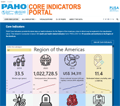
TERRITORY PROFILE
Virgin Islands (British)
The Health in the Americas+ country and territory profiles are based on the interagency indicators available as of the dates referenced. The sources are referenced in this table. In some cases, the values of the indicators may differ from the most recent data available in the country.
Environmental and social determinants of health
In 2000 the total population of Virgin Islands (British) was 20 104 inhabitants; by 2023 this figure had risen to 31 538, representing a 56.9% increase. Regarding the country’s demographic profile, in 2023 people over 65 years of age accounted for 10.5% of the total population, an increase of 5.7 percentage points compared to the year 2000. In 2023, there were 107.5 women per 100 men and 76.8 older people (65 years or older) per 100 children under 15 years of age, as can be seen in the country’s population pyramids, distributed by age group and sex (Figure 1). Considering the population between 15 and 64 years of age to be potentially active (i.e., potential participants in the labor force), this group represented 75.8% of the total population of the country in 2023 (23 919 people). When we add these figures to the potentially passive population (4 311 under 15 years of age and 3 309 over 65 years of age), the result is a dependency ratio of 31.9 potentially passive people per 100 potentially active people. This ratio was 44.9 in 2000.
Life expectancy at birth in 2023 was 76.5 years, lower than the average for the Region of the Americas and 2.6 years higher that in 2000.
Figure 1. Population pyramids of the Virgin Islands (British), years 2000 and 2023
The unemployment rate in 2022 was 6.2% for the total population. The literacy rate was 96.9% in 2010 (96.3% for men and 97.2% for women).
Digital coverage
In 2017, 77.7% of the population had an internet connection, representing a considerable increase from 2002, when 18.9% of the population had an internet connection.
Health situation
Maternal and child health
Between 2011 and 2017, infant mortality in Virgin Islands (British) increased from 6 to 16.5 deaths per 1000 live births, a decrease of 175.0% (Figure 4). The percentage of low-weight births (less than 2500 g) increased from 10.8% to 11.9% between 2005 and 2017.
Regarding the immunization strategy, measles vaccination coverage was 73.0% in 2022, a decrease of 26.0 percentage points from 2000.
The maternal mortality ratio for 2017 was estimated at zero deaths per 100 000 live births. In relation to fertility, it is estimated that in 2023 women had an average of 1.0 children throughout their reproductive lives. In the specific case of adolescent fertility, there was a 69.9% decrease, from 45.4 live births per 1000 women aged 15 to 19 years in 2000 to 13.7 in 2023. In 2017, 100.0% of births were attended by skilled birth personnel.
Figure 2. Infant mortality per 1000 live births, 2011–2017
Communicable diseases
In 2020, there were 3.9 new cases of tuberculosis per 100 000 population in the British Virgin Islands.
In 2017, the estimated human immunodeficiency virus (HIV) infection incidence rate (new diagnoses) was 8.6 per 100 000 population.
Noncommunicable diseases and risk factors
In 2010, the reported prevalence of arterial hypertension (high blood pressure) among people aged 18 years or older was 8.2. The prevalence of diabetes mellitus which stood at 8.7% in 2021.
Mortality
The crude mortality rate was 4.72 per 1000 population in 2017, an increase of 27% compared to 2010 (3.71 deaths per 1000 population).
The health situation and the COVID-19 pandemic
In British Virgin Islands in 2020, there were 95 cases of COVID-19, representing 2989 per million population. In 2021, there were 3304 identified cases, equivalent to 106,196 per million population; in 2022 cases increased to 125,610 identified cases, equivalent to 2057.07 per million population. In 2020, there was only 1 death directly caused by COVID-19 in people diagnosed with the disease, or 32 million population; in 2021, 39 deaths were reported, or 1,221 per million and reduced to 25 deaths, or 804 per million population in 2022.
In 2020, the British Virgin Islands ranked 45th in the Region of the Americas in terms of the number of deaths from COVID-19, and 44th in 2021.
As of 31 December 2021, at least one dose of COVID-19 vaccine had been given to 63.7% of the territory's population. As of 2 July 2022 (latest available data), 47,6% of the population had completed the vaccination schedule. The vaccination campaign began on 20 February 2021, and two types of COVID-19 vaccine have been used to date.
Prospects
Measures to achieve universal health coverage
In 2018, the British Virgin Islands Health Services Authority began a pilot chronic-care program to improve the management of chronic diseases in the territory. The program is part of the multipronged chronic-care model, a well-established framework shown to improve the care of patients with chronic diseases. A self-management program is being coordinated by the Ministry of Health as part of this initiative. The Social Security (Amendment) Act of 2014 established the Virgin Islands National Health Insurance, and the scheme officially started in January 2016. The fund provides health care to all residents contributing to the scheme, and is an important financial component of universal health coverage.
Challenges related to population health
The population of the British Virgin Islands is aging, and the increasing proportion of older adults is predicted to continue. In 2020, the proportion of the population aged 65 and older was 10.2%. This proportion is predicted to rise dramatically to 19.2% by 2040, and 25.7% by 2060. Life expectancy was estimated at 79.4 years in 2021 (77.7 years among men and 80.8 years among women) and is expected to rise toward the mid-80s, reaching 83.5 years by 2040, and 86.9 years by 2060. These anticipated life expectancy rates are below estimated rates for much of Western Europe, but above many life expectancy estimates for the Caribbean. As with much of the region, the main challenge for the British Virgin Islands is the increasing burden of noncommunicable diseases. Based on information up to 2010, cancers were the leading cause of death, and the proportion of all deaths due to cancer, heart disease, strokes, and diabetes was above 40%.
COVID-19 pandemic response
The British Virgin Islands escaped community transmission of COVID-19 until mid-2021 and has since seen two sharp outbreak peaks, in July–August 2021 and January–February 2022, with most of the 63 confirmed deaths by July 2022 occurring in these two outbreaks. In 2020, the Government of the Virgin Islands produced a comprehensive national action plan against the COVID-19 Pandemic. The Government has taken a strategic approach to preparing for, reducing the impact of, responding to, and recovering from a pandemic. Central to this approach are three overarching goals and a six-phase planning strategy. The three overarching goals are to protect the territory's people, society, and economy during and after a pandemic and are in line with the Government's goals for managing any crisis. The essential functions giving effect to these goals are of an all-of-government nature, although they maintain a health focus in line with the nature of a pandemic emergency. The six-phase strategies are summarized as: (1) Plan For It (planning and preparedness); (2) Keep It Out (border management); (3) Stamp It Out (cluster control); (4) Manage It (pandemic management); (5) Manage It: Post-Peak; and (6) Recover From It (recovery). A major ongoing COVID-19 policy is the further scale-up and implementation of the vaccination program in cooperation with international partners.
The sources of the interagency indicators used in this profile can be found in this table.
 For the latest data on health indicators for the Region of the Americas, be sure to visit the PAHO Core Indicators portal.
For the latest data on health indicators for the Region of the Americas, be sure to visit the PAHO Core Indicators portal.



